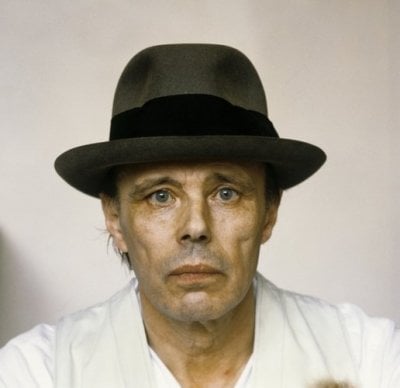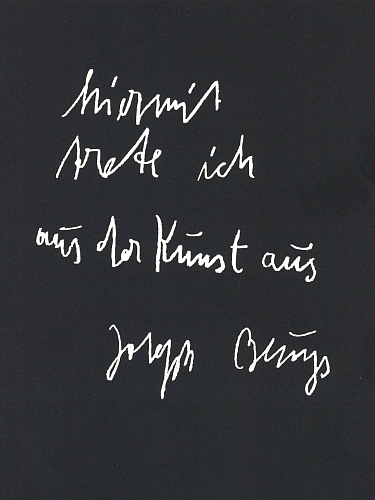
By creating his arguments against the "art elites of the world", Joseph Beuys devalued the work of artists who had been busy since centuries trying to develop valuable skills on the Figurative Art.
Beuys was a very special phenomenon after WWII in Germany, where not many artists had survived, and many artists were not left in a safe mental condition after the end of the war. The brilliance of the German art history had gone lost. The wonders of Schiller and Goethe had become suspicious to the disenchanted German masses. Very few survivors, like Klaus Mann, committed suicide. In sum, the aftermath of the war was a terrible time for the German arts, as the historical presence of the National Socialist Art in Germany left the visual artists with a generalized aversion towards the figurative (realist) art. Possibly, Germany never recovered from that problem, as it became hard for the culture to see reality, also by the compulsive denial (Verdraengung) that the people were historically forced into. The Verdraengung or repression of anything related to the war meant social survival and a fast escape from the historical responsibility towards those who were harmed: Everyone tried to pretend that they didn't have anything to do with the Nazis before the end of the War. Reality was intentionally evaded. People tried to forget and start anew.
But, the evasion of any reality that could bring memories to the Art of the National Socialists, left the German artists in a complicated lack of discipline. The artists in Western Germany after the war were no longer trained or required to develop skills in the figurative realism, because the culture evaded to see reality through its own historical mirror. History had become too horrible to admit that most of the fathers and brothers in the society had been directly related to the brutalities of the war, and to the extermination of their own folks. All kinds of speculative theories arose in the German society, making believe that something new was being born. Among those "new artists" in Germany were German artists such as Kinski and Beuys. Both of these artists were characteristic for their deconstruction of history and their reconstruction of a "new" artform that would on the one hand disconnect the German culture from its immediate past and on the other hand it would produce instant muses that would be looked up by the masses. The argument of war trauma became a legitimation to perform in the new art form that would not resemble National Socialism and its obsession with perfectionism; the war traumatized individuals became the new "artists" without having to deal with the disciplines of the art. Emulating the USA and Warhol, the German culture happily erected craziness and trauma to the stage of the world art, and everybody was happy.
While in the USA Warhol was an industrial phenomenon that helped the market, the "Entartung", or "lack of artistry" in the arts became culturally accepted and seen as new form of "artistic development" in Germany, particularly because the Nazis had tried to banish it. During the Post-War period of art history, one can see in Germany a preference for the "art" that resembles chaos, lack of skill and the idea that "all is art", which impoverished the teachings given to students in the art schools. Whole generations of new West German artists came out of the art academies not being able to draw, paint, or to create sculpture. In the East, Germany was too busy trying to escape back into the West, to even care about art. Many depictions of the Socialist Realism were sponsored by the Communist State and a new art form of very rigid images not too far from the National Socialist rigidity became popular. Both sides of Germany were forced through the development of history to assume an interpretation of "contemporary" art that was affected by the war and the nationalist ideologies that caused it.
The German culture has not been able to recover from its own choice to destroy the Figurative Art after the NS esthetic ideal of Hitler and his cronies didn't pass through the scrutiny of the world art scenario. The lack of connectivity of this new German art development of the Post War Period with the history of art and with the importance of the Figurative Realism has remained a problem for any figurative artist today in Germany, as there is no audience and no cultural development ready to bring the culture back into the study of reality through the cultivation of the Figurative Art on a widespread scale that should start with the elementary and high school education.
Such lack of connectivity between culture and its reality poses a problem, because in the absence of figurative realism, the culture has been kept under a social and aesthetic handicap that can't be solved, because the masses have remained paralized under a collective denial, unable to stand up and take over their own art history without evading the period of the German war. Social studies would call that phenomenon of cultural evasion, a form of "alienation" or the German word "Verdraengung", the collective purposed denial of a historical past, and the objective focus on deviating the public attention from any events or activities that occured before the end of the war. But, they didn't notice that by deleting National Socialist Art, they also deleted Classic Art, the Figurative Realism and most importantly the skill that was accomplished by generations and generations of artists before the Nazi Art came into history.
Almost around the same time of history, the world saw a similar phenomenon in the art by Andy Warhol, when he was blown into fame for doing something "new" that appeared to revolution the icons of mass industry. But, Warhol and Beuys were products of the Cold War, when the idea behind that "new" art was to demoralize the Russians.
Very little attention was then given to the fact that the Moscow Art School continued producing excellent masters of the arts, in spite of the structural poverty that they faced.
Another aspect of the Post-War deconstruction of the Art that remains unspoken is that, in spite of the lack of art appreciation that was given by the media in the Western societies during the Cold War for the work of the Realist Russian masters, and although there was little cultivation of the Figurative Art after the war, the simple skill of the genuine mastery of the art found its own way into the hall of public recognition: While the National Socialist and Social Realist Art drove the German public to despise anything that could be interpreted as Figurative Art, many artists from the Figurative School of Moscow ended up emigrating to the United States, where they found success and specially happily paying customers, who thankfully allowed the Russian Masters to make a decent living by selling their work in a healthier market for the Realist Art, like Vladimir Kush and many others.
Meanwhile, Germany is still struggling to return the universal values of Figurative Art to a shuttered society, whose art and culture are still affected by the social-psychiatric burdens of WWII.
Joseph Beuys most likely understood all of the above, as he eventually wrote in his own language: "Hiermit trete ich aus der Kunst aus." Meaning, "With this, I resign from art."

KVS - Copyrighted Material - SABAM 2013